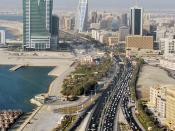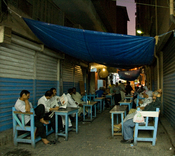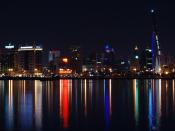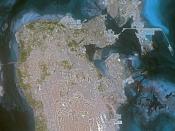Auckland is on the north island of New Zealand. It has a temperate range of temperature of 9oC throughout the year, ranging from 10oC to 19oC. Since Auckland is located in the southern hemisphere, the Summer is from December to April, which is the warmer temperature of an average of about 16oC or above, and Winter is from May to November, the cooler temperature averaging 13oC, 15oC or below . It has a lower temperature during May to October in the year, as the average temperatures of each month during this time are lower than 20oC. Auckland has a cool-temperate climate with no temperatures exceeding 20oC. Auckland has warm, humid summers and mild, damp and cool winters. Auckland rains non-stop throughout the whole year, however, is still considered dry compared to sub-tropical regions. The total rainfall reaches 1163.6mm in a year, and it rains more in the winter (May to November) and less in the summer (December to April), and the rainfall is not evenly distributed throughout the year, but it changes gradually, a gradual increase from January until July, and then gradually drops again, and there are no sudden gaps in between.
Manama is the capital city of Bahrain. Ranging from 18oC to 34oC, a 16oC difference, the temperature range is a considerable large one. The hottest temperature is from April to October, averaging 28oC, temperatures of 25oC or above, and the coolest temperature is from November to March, temperature range of 17-25oC. The graph created shows a parabola relationship of the temperatures of Manama throughout the year, cool in January, gradually rises to hot in July, and gradual drop of temperature in the winter again. However, the general trend is still warm to hot. ManamaÃÂs total annual rainfall is 70.5mm, which makes it an extremely dry city, and of which 4 months (June to September) that had absolute no rainfall. And considering it doesnÃÂt rain much, the rainfall season is in the winter, from December to April.
Basically, the main differences are the trends of temperatures, and rainfall. The trends of the two cityÃÂs temperatures are totally contrasting. Auckland has the winter around July, while Manama has the summer around July. This means that the parabola trends are totally reversed. Also, Auckland rains non-stop throughout the year (not a lot though), while Manama hardly rains, and even 4 months of no rain at all. Also, Auckland is a cool place, and Manama is a warm/hot place.
Auckland is in the climatic region of Warm temperate rainy climates. The symbol ÃÂCfÃÂ represents ÃÂclimate with no dry seasonÃÂ, which is even rainfall throughout. Auckland is located 41o south, so in the southern hemisphere, it experiences summer in December, and winter in July. This is due to the tilt of the earth. The temperature is moderated by prevailing winds that blow from the Southern seas, due to the ÃÂwesterliesÃÂ. However, during November to April, it experiences warmer temperatures, because of the tilt and the sun rays hit the Southern hemisphere in a direct angle of incidence. In the winter itÃÂs colder, since the land cools much faster than the ocean, and so the air pressure is higher than the oceans. On the contrary, during the summer, the wind carries moisture from the ocean, and since the northern coast of New Zealand is surrounded by water, the winds bring along moisture, and keep the even distribution of rainfall. Another factor of the cool temperate weather is due to the elevation. It is predominately mountainous, so the overall temperature may seem cooler, than flat low-lands. This is due to the thin atmospheres, and the decreased air pressure, which are less capable of trapping heat, therefore resulting in cooler temperatures.
Manama is in the climatic region of ÃÂDry climatesÃÂ, BW representing Desert climate, meaning to say itÃÂs with a wide range of temperatures with little or no rainfall, and is located in a gulf. As it is in the Northern hemisphere, the seasons are the same as what we experience, summer in July, and winter in December. Even though the island is surrounded by water, but due to the climatic region it belongs to, Manama barely rains. And the range in temperature is due to continentality. The land heats up really fast and cools really rapidly, since its solid land, while the sea takes much longer for the same process, and then usually acts as an insulator. Also, Manama is affected by the Northeast trade winds. Another factor of the warm temperature is due to the lowlands.
The climate of Auckland and Manama differ because the two cities are in opposite hemispheres, and are in different climatic zones, and experience different prevailing winds, and also continentality. Although the two are both surrounded by water, but Manama receives rainfall almost next to nothing annually, while Auckland receives rainfall all year round. All of the aspects affect the climates greatly.
I would much prefer to live in Auckland, in New Zealand, than in Manama, Bahrain, mainly due to my dislike of extreme large temperature ranges. Despite the long-term rainfall in Auckland, the mild temperature is a comfortable environment to live in. No extreme hot or colds, and no extreme weather either. It is an ideal place to live in.





